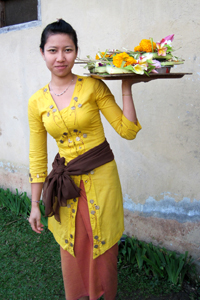
About Bali
Our Handmade Silver is produced on the tropical island of Bali. Bali is a small island nestled in the Indonesian archipelago, which stretches from Singapore to Australia. It enjoys a well deserved reputation as one of the most beautiful spots on earth. The people of Bali live and work in a setting of terraced rice fields, volcanoes and lush tropical growth. From intricate palm leaf offerings, to ornately carved temple walls, they festoon their island with art that is worthy of the landscape.
The Balinese practice their own form of Hinduism, which is an integral part of daily life, and many of their artistic traditions have developed in relation to their faith. In recent decades, however, they have adjusted to the demands of a global economy by using their love of art to fuel a thriving export industry. They produce a wide array of handicrafts that include textiles, wood carving and Bali silver jewelry.
While there is debate about Bali’s prehistoric history, there is ample proof of a well developed Megalithic culture. Nevertheless, good documentation about Balinese culture does not begin to emerge until the 8th or 9th century A.D. At this point the Balinese had already begun to practice various forms of Buddhism imported from India and there is evidence of Hindu influences as well. From the 10th to 11th century, Hinduism continued to merge with local customs. Through intermarriage, Javanese culture began to permeate royal court life and later spread to the villages.
The Hindu Majapahit Empire of Java conquered Bali in the 14th century. (The Majapahit imposed a caste system on Bali with themselves on top and the original inhabitants of the island on the bottom.) By the beginning of the 16th century Bali became a sanctuary for Hindus forced out of an increasingly Islamicized Java. As the Majapahit Empire crumbled, there was a huge influx into Bali of Javanese noblemen and craftsmen.
Indonesia’s wealth in spices, precious stones, gold and other exotic items have attracted traders for centuries. The islands in the Indonesian Archipelago were natural way stations on the trade routes between the Middle East, India and China. The Balinese were never an active seafaring people. It was the Chinese, Indians, Arabs, Malays, Javanese and Bunganese who plied the trade routes. Later came the Portuguese, English and Dutch.

Bali has no naturally protected harbors and the coastline is notoriously perilous. Many coastal villages profited routinely by plundering shipwrecks. One such incident provoked the Dutch invasion of 1906, which was relatively late in their 300 years of colonial rule in Indonesia. Despite the bloody conquest, Balinese culture was relatively undisturbed for most of the years of Dutch occupation, partly because Singaraja, in the north of the island, was the only place that ships could anchor in relative safety and travel in the interior of the island was difficult. Ships from all over South East Asia stopped to exchange goods in Singaraja but for the most part, before the advent of airplanes, only the inhabitants of the north end of the island were directly exposed to foreign influences. Nevertheless, the Dutch did exploit the island vigorously, siphoning off essential resources through an efficient and clever system that used the local aristocracy to do their bidding. After the Dutch, Bali endured an era of Japanese occupation during World War Two and then became part of an independent Indonesia. Under Presidents Sukarno and Suharto political loyalties continued to shift the balance of power. Technically the aristocracy and the Brahmins (priestly caste) no longer “rule” but in practice they still enjoy a large measure of power and privilege.

The arrival, in the last few decades, of tourists, export industries and technology, have had many easily observed effects. The Balinese usually dress in Western clothes, they send faxes, roar down the streets on motorbikes and watch TV. But such changes can be misleading.
Beneath the surface Balinese reality is vastly more inclusive than Western consciousness allows. The Balinese have a word, “sekala,” for things which you can perceive with your sense of vision, hearing, smell or touch. There is another word, “niskala”, for “that which cannot be sensed directly , but which can only be felt within.” In the West, we only recognize sekala phenomena as “real”, but in Bali they make no distinction between the two.
Mystical forces, both malevolent and benevolent, occupy a central role in Balinese life. The principal Hindu-Balinese rituals and ceremonies are concerned with maintaining the balance between positive and negative forces. Demons and witches, called leyaks, are not creatures of fairy tales but dangerous and common menaces against which everyone must be on guard at all times. Objects and places which are considered inanimate in the West may be charged with mystical power and therefore very much alive to the Balinese. For this reason, they make offerings to many objects, including the tools used to make silver beads and the building in which the silversmiths work. Directions, numbers and dates can be charged with “kasaktian,” which means “magical power.” Every activity must be carried out with careful consideration and the Balinese often consult religious authorities for propitious dates for important events. The Balinese also accept dual realities, something may be true, but not true, and in certain circumstances they reject linear time.
